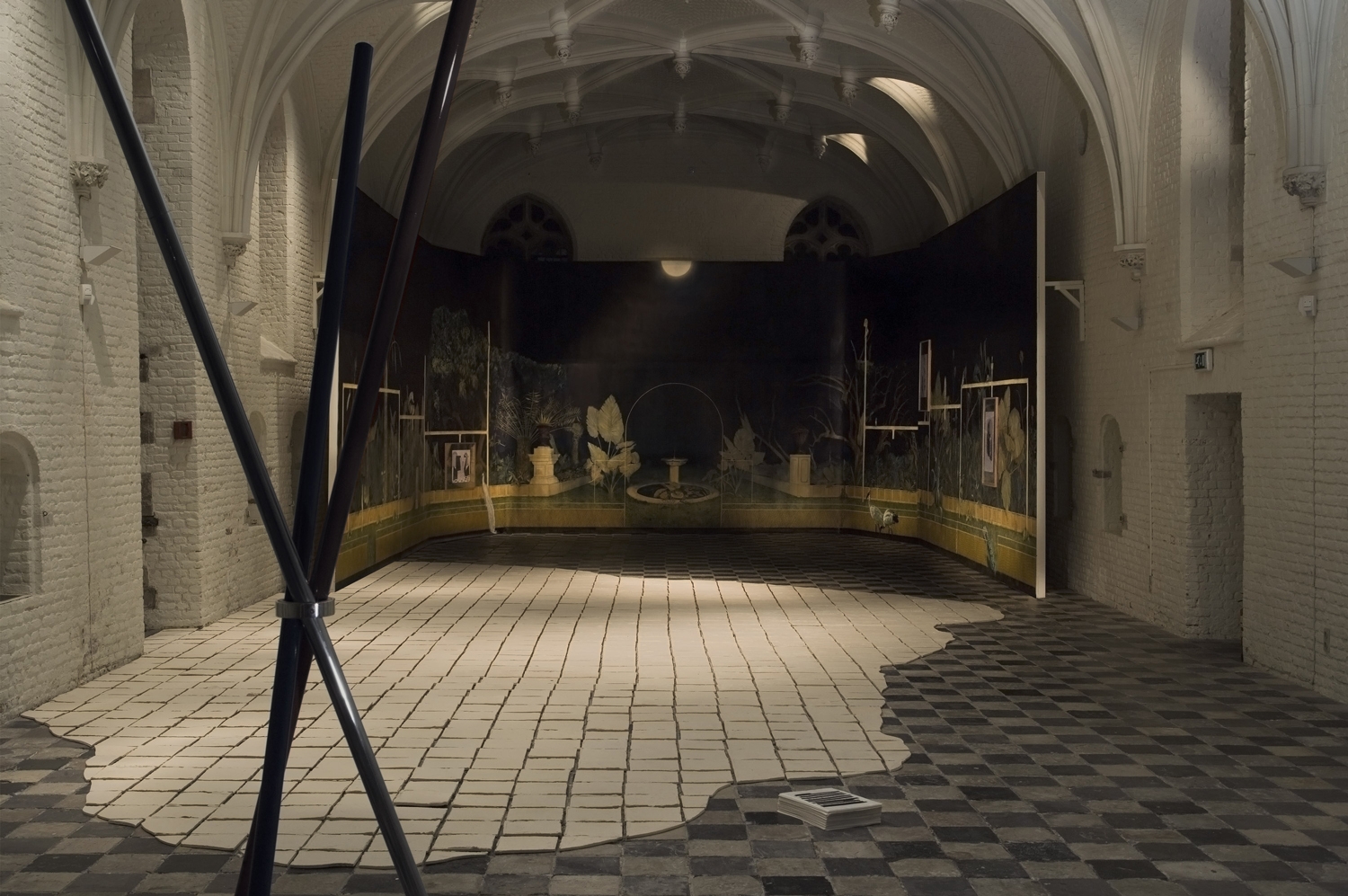The Gardens of Sardinia, Cyprus and Jerusalem
Paolo Chiasera
Solo exhibition
15 November – 14 December 2014
Vleeshal (Map)
Curator: Lorenzo Benedetti

The Gardens of Sardinia, Cyprus and Jerusalem is a project by the Italian artist Paolo Chiasera realized both at MAN Museum of Nuoro in Sardinia (Italy) and Vleeshal Centre for Visual Arts in Middelburg (Netherlands).
The work follows an itinerary undertaken by the artist in 2011 with his elaboration of the concept of 'Exhibition Painting', a genre that he invented featuring the creation of canvas based exhibitions, which may include works by different artists, done in the past or commissioned for the occasion. The painting is conceived as a place for artists, curators and institutions to come together and exchange ideas.
Continuing this research, Chiasera developed Secondo Stile, a nomadic artist run project space, which in its name Second Style, refers to a stylistic development in Roman art, characterized by the emphasis on power of imagination. This imaginary represents the ideal space for experimentation and the definition of artistic production following new modes of exhibition.
With The Gardens of Sardinia, Cyprus and Jerusalem, Secondo Stile enters the museum for the first time. In this context Paolo Chiasera reflects on the recurrence of the life cycle, symbolized in palaeolithic and neolithic culture, which is permeated by a religion closely connected with the cult of the Mother Goddess, nature and her manifestations in earth and water. Through reflections on the cyclic nature of life and human history, cultural heritage in different historic periods and territorial contexts, Chiasera has arrived at a singular interpretation of the permanent collections of the museum of MAN and De Vleeshal, in a vision that weaves together archaeology and the contemporary world.
Starting from the emotions stirred by a visit to the gardens of the 18th-century Villa d’Orri in Sarroch, Sardinia and the atmosphere of the Augustan Villa of Livia in Rome, Paolo Chiasera evokes a nocturnal garden on canvas, in the space of which, together with the co-curator Micaela Deiana, he proposes a selection of works from the collection of De Vleeshal.
In the gothic space of De Vleeshal the Garden of Sardinia, Cyprus and Jerusalem will incorporate the ceramic installation The ground of the Sea (2009) by Katinka Bock, which analyses how elements of a space may display the traces of time. This work from the collection of De Vleeshal creates a relationship between the space’s interior and exterior landscapes, and relates to the longstanding Dutch tradition of landscape painting. The sculpture Illuminati (2009) by Riccardo Previdi, is a self-supporting structure made up of polished and varnished aluminum tubes. Like the scattered sticks of the game Mikado, the tubes draw and reflect lines of color on the regimented black and white pattern of the flooring, blending together the characteristics of the architectural environment. The third work from the collection, also specifically related to the exhibition space of De Vleeshal is the documentation of Innere Stimme by Olaf Nicolai, a continuous performance that took place at De Vleeshal in 2010. It is based on Robert Schumann’s Humoreske Opus 20 for piano, a composition written for unaccompanied piano, where the middle staff cannot be sung, but the melody will influence the interpretation of the piece. The audience of the music, unable to see the score, can only imagine the influence of the 'Inner Voice'. The dialogue between the three works and The Gardens of Sardinia, Cyprus and Jerusalem will be accompanied by photographic documentation of the solo-exhibitions of Bock, Previdi and Nicolai at De Vleeshal, paying homage to the artistic direction of De Vleeshal’s former director Lorenzo Benedetti.
Text: Micaela Deiana
Series
Vleeshal is a unique center for contemporary art, not only because of its atypical exhibition space and exciting programming, but also because it has a collection. In the 1990s, under the impetus of then director Lex ter Braak, an ambitious collection of contemporary visual art was begun. This collection was intended for a newly envisioned museum in Middelburg, designed by Aldo and Hannie van Eyck. In 1995 it became clear that, unfortunately, there was insufficient political support for this museum. The impetus of collection building had therefore lost its possible context and visibility and encumbered Vleeshal. The collection had become a storage cost and management issue.
In 2005, the collection was given on a long-term loan to M HKA in Antwerp. M HKA was chosen because of the close historical ties between Middelburg and Antwerp, the museum's collection profile, and the fact that M HKA's director, Bart De Baere, was a member of the committee that purchased artworks for the yet-to-be-built museum in Middelburg in the 1990s.
The collection consists of two parts. One part includes national and local art from the BKR arrangement (the Dutch abbreviation BKR stands for Beeldende Kunstenaars Regeling, an arrangement, which from 1949 to 1987 provided artists with a temporary income in exchange for works of art or other artistic quid pro quo). The other part consists of artworks by international contemporary artists (including Jimmie Durham, Nedko Solakov, Suchan Kinoshita, Cameron Jamie, Pipilotti Rist, and Job Koelewijn).
There has been no active acquisition policy for years. The collection is expanded here and there with sporadic purchases and donations from artists who are part of the Vleeshal program.